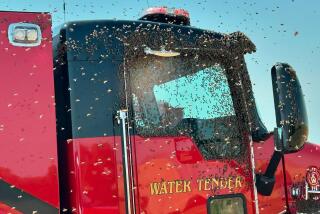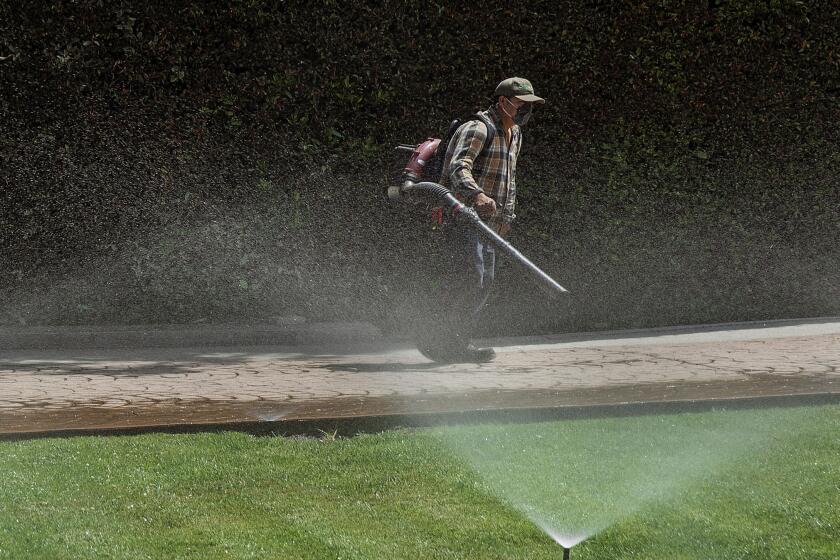Flight of the honeybees
- Share via
SOMETHING strange is happening to honeybees. They’re vanishing. In parts of the country, bees are leaving hives and not returning. The phenomenon, dubbed Colony Collapse Disorder, has wiped out a quarter of the hives of commercial beekeepers since last summer, according to the American Beekeeping Federation, and set off a flurry of debate about how to stop it, whatever it is, and what it all means. Though scientists from UC San Francisco announced Wednesday that they had identified a parasitic fungus and a virus as two potential causes, the culprit or culprits behind a national phenomenon still have not been definitively confirmed.
As if out of some lost Rod Serling script, this warp in the daily rhythms of a tiny creature has potentially big consequences. Bees, after all, don’t just make honey.
“One-third of our daily diet is based on crops produced by honeybee pollination,” says Eric Mussen, an entomologist and bee expert at UC Davis who believes Colony Collapse Disorder has the potential to threaten U.S. food production. Crops that rely on bees, he says, represent “the lion’s share of our fruits and vegetables.”
But it’s not just at the dinner table where these unsung constant gardeners may be missed. Bees are as essential as water or sunlight in home gardens, Mussen says. The sight of these hairy-legged bugs clambering around your flowers and fruit trees should not prompt calls to the exterminator but, instead, should touch off celebration.
Being a few shovel-lengths away from 50,000 bees would spur many gardeners to sprint for the nearest shed, but at the Crenshaw Community Garden, the throng of bees is a groundskeeping crew, tending robust clumps of Korean parsley, onions and berries.
“It seems like a lot, but it’s only the size of a basketball,” says Anna Bonner Mieritz, an L.A. gardener and bee hobbyist whose triple-drawer hive is abuzz with activity. “They really are sweet, friendly creatures.”
Over at her plot, an intent squad of honeybees stuffs their heads down the flutes of lush lavender blossoms. Although Mieritz hasn’t had any problems with Colony Collapse Disorder, she sees the epidemic as an opportunity to “open eyes about smaller, local agriculture,” which isn’t subject to the chemical and nutritional stresses of big agribusiness.
It’s also a chance to raise awareness about this little-understood bug and the sting that can result when we swat the hand that feeds us.
Without bees, salad bowls and fruit platters would be bare and pricey. Honeybees supplied by commercial beekeepers are responsible for pollinating more than 90% of the country’s annual crops of carrots, cucumbers, broccoli, onions, pumpkins, squash, apples, blueberries, avocados, almonds and cherries. Peaches, grapes, melons, sugar beets and alfalfa -- critical to the dairy cows producing the milk for your Frosted Flakes -- also depend heavily on the pollination by bees.
Shunned as pests, these troupers lend nature, and us, a big hand. They never ask for a raise and will work for food -- the nectar and pollen that will be turned into our honey and their winter stores. In the process, bees operate as reproductive FedEx guys, delivering pollen grains caught in their hair from the male part of the flower to the female part, an operation that sometimes, as in apples, involves trips between different trees to produce fruit.
Without pollinators it’s mutiny on the bounty. So far the disorder has affected mostly commercial beekeepers, particularly in the East. Troy Fore, executive director of the American Beekeeping Federation in Jesup, Ga., has lost 40% of his colonies this year and says some keepers have suffered losses of 90%.
A Congressional subcommittee held hearings on the problem in March, and a Southern California environmental group, Empowerment Works, convened a press conference last week to raise awareness about the issue. Though no one has quantified the disorder’s effect on home gardens, the mystery has alarmed some backyard tillers who know just how important these critters are.
“There’s good research that the more bees pollinate your fruit trees, the bigger the fruit,” says Amy Stewart, author of “Flower Confidential: The Good, the Bad, and the Beautiful in the Business of Flowers,” who just bought a colony of bees for her Northern California home. “Even for shrubs and flowers it’s important for bees to pollinate them.”
Local bee enthusiasts say they haven’t experienced major losses from Colony Collapse Disorder. Hop onto online forums, however, and you’ll read comments about missing bees from the Bay Area to L.A., with one Angeleno lamenting on Salon.com that rosemary and sage blossoms are devoid of bees this year. “It’s the kind of thing Vonnegut might have based one of his ironic post-apocalyptic visions upon,” the entry says. “Are we paying attention yet?”
DESPITE all the gardeners who appreciate bees’ importance, the bugs have a long-running image problem with most folks. PR highlights have been few and far between Rimsky-Korsakov’s “The Flight of the Bumblebee” and Bit-O-Honey. Bees are written off as sting-from-the-hip automatons, more menacing than ever thanks to the hype about Africanized bees. Although Africanized bees can be a hazard, a honeybee swarm definitely isn’t.
“You can walk right into it,” says Mace Vaughn, an entomologist for the Xerces Society, a nonprofit in Portland, Ore., formed to protect habitat for bees, butterflies and other pollinators. “They don’t have anything to defend. Bees only sting when they feel they’ve got something to defend, like all their food and young in the hive. When they’re at flowers or swarming, they’re actually harmless.”
Bees are blamed for breaking up picnics, barbecues and campsites when the perpetrators are actually wasps, which are carnivores. Bees are strictly vegan. “We lump them all into this pest category that we need to destroy or be afraid of,” Vaughn says.
“People have this automatic association with killer bees,” says Lisa Freeman, a Mar Vista publicist who got to know the real bee story when a hive took up residence on her front-porch patio. After the colony went to work in her yard, a huge avocado tree that had been barren for years started to sprout fruit, and her plum tree was “bursting.”
Bees can make a vegetable patch yield so many zucchini, “you hardly know what to do with them,” Mussen of UC Davis says. “If you put a net over some of those female zucchini flowers and don’t let the bees in there, it’ll be very short and crooked. None of them will grow right if they don’t get pollinated well.”
If you want a thriving garden or fruit tree, you need bees. You can hope scouts find your flowers, though the bees may not like some blooms, including roses. Or you can hope that someone in the neighborhood has a beehive. Or you can make your own yard more bee-friendly.
Though the feral honeybee population is almost extinct in California because of a mite infestation and development, there are alternatives. You can buy your own hive for $250 to $300, or you can try to attract the three main types of feral bees: bumblebees, which nest in small cavities; wood-nesting bees; and ground-nesting solitary bees.
Rule of Bee Attraction No. 1: Make sure you have early flowering plants. After hibernating during winter, queen bees emerge from their slumber at the first sign of warm weather to look for a nest and flowers to feed the brood. The more flowers that are close to the queen, the faster the colony can grow and tend gardens. Willows are a big early hit for bumblebees. Lilacs too.
As in any good restaurant, you need to have a diverse menu. Your garden should have an assortment of appetizers, including shrubs and fruit trees. Bees have a special hankering for herbal fare. It’s hovering-room-only around rosemary, thyme, sage, parsley and blue basil.
The next step requires a departure from prevailing garden aesthetics and leaving parts of the yard a mess.
“If you can find a corner of your yard that can strategically be made messy, that works very well,” Vaughn says. “That helps provide nest sites for bumblebees. They need places where the ground’s not being turned over year after year. In my yard all I have to do is clear away some grass.”
THERE’S no bee shortage at one Eagle Rock home. On a back patio at the base of a hillside, an artist and bee fancier watches the action through a pair of binoculars at a landing strip busy enough to rival LAX. The hive at the end of his yard is in desperate need of air traffic control. Robber bees, outsiders from a wild colony nearby, crash into the front screen and pile up at one corner while the hive’s defenders try to ward them off.
“Sometimes you see them fighting, rolling around on the ground,” says Patrick, who declined to disclose his last name because of anti-bee neighbors. “They’re fascinating on every possible level. They’re a great gateway into nature. Bees react to the same seasonal rhythms you see when you’re raising vegetables or plants.”
He can watch them coming in with pollen, then going, then coming. “It’s like sitting in front of the fire.”
It’s a ritual he hopes will be around for a while, despite Colony Collapse Disorder. Researchers are still looking for more answers about why the bees are violating their prime directive and not reporting back from the field. The lack of victims to autopsy is problematic -- when it’s a bee’s time to die, it departs the hive.
But as the search for answers continues, there is consensus on one thing. Man’s true best friend may be a blue-collar insect without whom life would be a lot less fruitful.
*
Building a hive of your own
FOR a beeline to your garden, try building your own hive. About 30% of the most common feral bees nest in wood tunnels, so entomologist Mace Vaughn suggests starting with a block of non-pressure-treated wood. Drill it full of holes that are 3/32 inch to 5/16 inch in diameter and about 5 inches deep.
The queen “basically fills those tunnels with girls,” Vaughn says. “For a farmer or a gardener, you want to maximize your girl production because those are the ones that are foraging mostly for the pollen and nectar.”
He says projects like this allow gardeners to understand these insects better and not be afraid of them. “Putting up a bee block and taking care of them helps you establish a relationship and know what these insects do,” he says. “That begins to change people’s perspective.”
-- Joe Robinson
*
Bee disorder
For more on the potential causes of the Colony Collapse Disorder affecting bees, see the story by Times staff writers Thomas H. Maugh II and Jia-Rui Chong in the A section.






